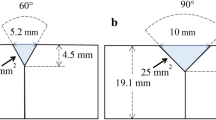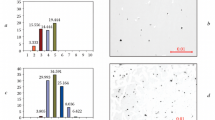Abstract
Submerged arc welding (SAW) is extensively used in pipe production. Because of the need for high toughness in a pipeline, it is necessary to develop wires and fluxes for high-efficiency SAW to produce weld metal (WM). Investigations are carried out in real spiral pipe production factory by the multi-wire double seam SAW process using constant welding parameters and the same flux. Two different chemical compositions of API-X65 steel and four different chemical compositions of weld electrodes have been used in this investigation to evaluate the effect of WM chemical composition on the mechanical behaviour of welded X65 steels. Vickers hardness, Charpy V-notch (CVN) impact toughness and tensile strength tests have been conducted. The toughness of the WM is lower than BM and HAZ. The WM toughness improvement depends on the weld electrode that is used and increases with increasing Mn content of the weld electrode used. The weld electrode contains B and Ti micro-alloy elements that can produce high toughness WM. The mechanical properties of WM are changed by using different weld electrodes. This work shows the importance of the selection of weld electrode composition in order to improve the mechanical properties of steel welds.
Similar content being viewed by others
References
Ghosh A, Chattopadhyaya S, Sarkar PK (2011) Critical analysis of confounded parameters of SAW process. Proc Eng 10:2786–2790
Hashemi SH, Mohammadyani D (2012) Characterisation of weldment hardness, impact energy and microstructure in API X65 steel. Int J Press Vessels and Pip 98:8–15
Chandel RS, Seow HP, Cheong FL (1997) Effect of increasing deposition rate on the bead geometry of submerged arc welds. J Mater Process Technol 72:124–128
Kolhe KP, Datta CK (2008) Prediction of microstructure and mechanical properties of multipass SAW. J Mater Process Technol 197:241–249
Kanjilal P, Pal TK, Majumdar SK (2006) Combined effect of flux and welding parameters on chemical composition and mechanical properties of submerged arc weld metal. J Mater Process Technol 171:223–231
Shen S, Oguocha INA, Yannacopoulos S (2012) Effect of heat input on weld bead geometry of submerged arc welded ASTM A709 Grade 50 steel joints. J Mater Process Technol 212:286–294
Li R, Zuo X, Hu Y, Wang Z, Hu D (2011) Microstructure and properties of pipeline steel with a ferrite/martensite dual-phase microstructure. Mater Char 62:801–806
Moeinifar S, Kokabi AH, Madaah Hosseini HR (2011) Role of tandem submerged arc welding thermal cycles on properties of the heat affected zone in X80 microalloyed pipe line steel. J Mater Process Technol 211:368–375
Shanmugam S, Misra RDK, Hartmann J, Jansto SG (2006) Microstructure of high strength niobium-containing pipeline steel. Mater Sci Eng A 441:215–229
Peng Y, Chen W, Xu Z (2001) Study of high toughness ferrite wire for submerged arc welding of pipeline steel. Mater Char 47:67–73
Paniagua-Mercado AM, Lopez-Hirata VM, Saucedo Munoz ML (2005) Influence of the chemical composition of flux on the microstructure and tensile properties of submerged-arc welds. J Mater Process Technol 169:346–351
Wang W, Liu S (2002) Alloying and microstructural management in developing SMAW electrodes for HSLA-100 steel. Weld Res 81(7):132–145
Powell GLF, Herfurth G (1998) Charpy V-Notch properties and microstructures of narrow gap ferritic welds of a quenched and tempered steel plate. Metall Mater Trans A 29:2775–2784
Graf M, Nıederhoff K (2000) Toughness behavior of the heat-affected zone (HAZ) in double submerged-arc welded large dıameter pipe. Mannesmannröhren-Werke A.G. 13:1–9, Düsseldorf, FRG
Zhang Z, Farrar RA (1997) Influence of Mn and Ni on the microstructure and toughness of C-Mn-Ni weld metals. Weld J 76(5):183–190
Bhole SD, Nemade JB, Collins L, Liu C (2006) Effect of nickel and molybdenum additions on weld metal toughness in a submerged arc welded HSLA line-pipe steel. J Mater Process Technol 173:92–100
Paniagua-Mercado AM, Lopez-Hirata VM, Dorantes-Rosales HJ, Diaz PE, Valdez ED (2009) Effect of TiO2-containing fluxes on the mechanical properties and microstructure in submerged-arc weld steels. Mater Char 60:36–39
Barbangelo A (1990) Influence of alloying elements and heat treatment on impact toughness of chromium steel surface deposits. J Mater Sci 25:2975–2984
Fox AG, Eakes MW, Franke GL (1996) The effect of small changes in flux basicity on the acicular ferrite content and mechanical properties of submerged arc weld metal of navy HY-100 steel. Weld J 75:330–342
Dixon B (1996) Submerged arc welding with alloy powder additions for high strength steels. Int J Join Mater 8(1):14–21
Liu S, Liao FC (1998) Precipitates stability in the heat-affected zone of nitrogen enhanced high strength low alloy steels. Mater Sci Eng A 244:273–283
Snyder JP, Pense AW (1985) The effect of titanium on submerged arc welds metal. Weld J 61(7):201–211
API 5L specification for line pipe 49 CRF 192.113 (2005) American Petroleum Institute, 43th ed. Washington D.C.
Sirin K (2004) The effect of welding parameters on weld quality in the submerged arc welded spiral pipe production. Ph.D. thesis, Kocaeli University
Linnert GE (1994) Welding metallurgy volume I, 4th edn. AWS, Miami Florida
EN 10002–1 (2001) Metallic Materials-Tensile Testing Part1: Method of test at ambient temperature
DIN 50115 (1991–4) Notched bar impact testing of metallic materials using test pieces other than ISO test pieces
Kiran DV, Kiran B, De A (2012) Influence of process variables on weld bead quality in two wire tandem submerged arc welding of HSLA steel. J Mater Process Technol 212:2041–2050
Author information
Authors and Affiliations
Corresponding author
Rights and permissions
About this article
Cite this article
Sirin, K., Sirin, S.Y. & Kaluc, E. Influence of the chemical composition of weld electrode on the mechanical properties of submerged arc welded pipe. Int J Adv Manuf Technol 87, 1941–1950 (2016). https://doi.org/10.1007/s00170-016-8546-z
Received:
Accepted:
Published:
Issue Date:
DOI: https://doi.org/10.1007/s00170-016-8546-z




